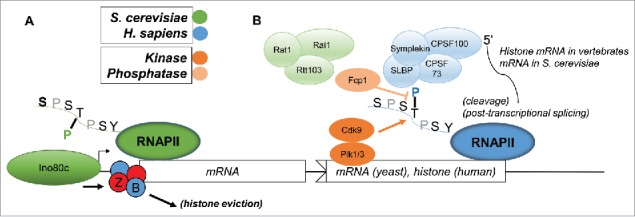Figure 2.

Divergent functions of Thr4 between S. cerevisiae and H. sapiens. (A) In S. cerevisiae, Thr4P has been shown to recruit the multi-subunit Ino80 chromatin remodeling complex to certain classes of promoters (see text), which evicts the promoter-proximal H2A.Z (red)/H2B (blue) histone dimers. Upon eviction of these dimers and replacement with H2A/H2B dimers, transcription of these genes is enabled. (B) In H. sapiens, histone mRNA synthesis requires Thr4 for efficient 3′ processing. Thr4 is required for recruitment of stem-loop binding protein (SLBP) and CPSF100, required along with other canonical 3′ processing factors such as Symplekin and CPSF73, to replication-dependent histone genes. In S. cerevisiae, histone mRNA 3′ ends are formed identically to all other mRNAs, and evidence shows that instead Thr4P plays a role in post-transcriptional splicing and Rtt103 (and Rat1/Rai1) recruitment during termination. In H. sapiens, Cdk9 and Plk1/Plk3 have been shown to phosphorylate Thr4, the later perhaps specifically in M phase, and Thr4P is dephosphorylated by Fcp1. Neither the kinase(s) nor phosphatase that acts on Thr4 is known in S. cerevisiae.
